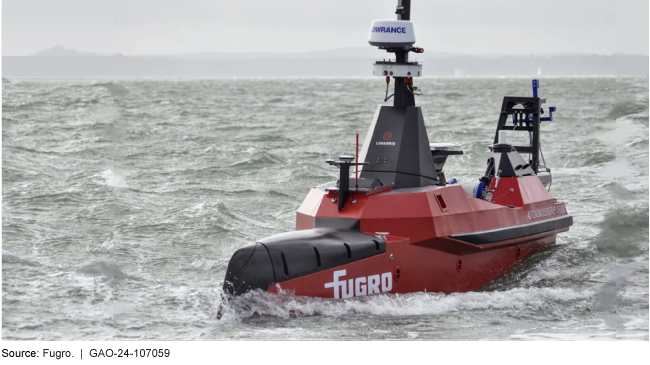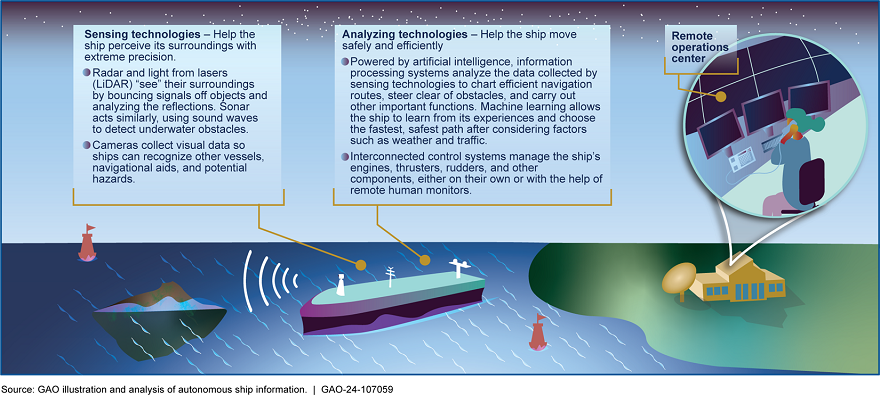Coast Guard: Autonomous Ships and Efforts to Regulate Them
Fast Facts
Autonomous ships could transform the maritime environment. These ships use various technologies to control speed and direction, avoid collisions, and navigate.
This Q&A discusses autonomous ships and how the Coast Guard—the federal agency responsible for the safety of U.S. waterways—regulates them.
Autonomous ships can reduce human error, among other potential benefits, but may also pose new risks, such as increased risks of a cyberattack.
While these technologies may allow for smaller crews, when in U.S. waters, such ships must still comply with the statutes that established minimum crew size by vessel.
This page was updated on August 8, 2024, to correct the spelling of the source of the photo.

Highlights
What GAO Found
Autonomous ships are developing domestically and abroad and have the potential to transform the maritime environment. These ships use various sensors and other technologies to control speed and direction, avoid collisions, and navigate with or without human input, whether onboard or from a remote operations center (see figure).
Examples of Commercial Autonomous Ship Technologies in Use as of June 2024

Current commercial uses are fairly narrow and involve a human that is either in direct control of the ship, or can take control, if needed. U.S and international industry stakeholders GAO interviewed described improved safety, efficiency, and workforce diversity, among other potential benefits. However, some expressed concerns and noted challenges involved in developing and proving these technologies for safe commercial use. Additionally, uncrewed or fully autonomous technologies may pose new safety risks in the maritime environment and could present challenges to a U.S. legal framework that requires (or is written with a presumption that) crew be aboard and in control of every ship.
The International Maritime Organization—a specialized agency of the United Nations responsible for the safety, security, and environmental performance of international shipping—is developing a regulatory framework for commercial autonomous ships that addresses issues such as safety, training, and legal liabilities. It is generally expected to be adopted by member countries on a non-mandatory basis in 2025 and in force on a mandatory basis for member countries in 2032 by amending an existing International Maritime Organization convention. The Coast Guard is the lead agency for the U.S. delegation to the International Maritime Organization and is helping to develop this framework.
Selected countries have taken various approaches to addressing autonomous ships. According to regulators from Canada, Norway, and the United Kingdom, these approaches include providing guidance to stakeholders on how to comply with existing laws and regulations, modifying regulations, and creating new regulations.
According to U.S. Coast Guard officials, the Coast Guard regulates the design, construction, and operation of autonomous ships through existing laws and regulations, which are sufficient for it to execute its safety mission. However, officials identified several factors that could constrain or complicate its ability as a regulator to enable the development and adoption of autonomous ship technologies. These factors include limited statutory authority to allow for reduced crewing on ships, a lack of domestic examples demonstrating autonomous ship technologies, and challenges in harmonizing international and domestic regulations.
Various statutes establish the minimum number of crew required per vessel, and Coast Guard officials told GAO that they do not have the authority to waive these requirements outside of the limited scope of the at-sea rocket recovery pilot program. However, officials said they have heard concerns from industry stakeholders that the inability to reduce crew below the minimum statutory requirements could make the capital cost of developing technologies that would take the place of crew—and thus save labor costs—impractical. Coast Guard officials said they monitor developments that could prompt a need for new or revised laws and regulations, and brief Congress periodically.
Why GAO Did This Study
Such ships range from crewed ships with automated processes and decision support to ships that can make decisions and determine actions without human involvement. These include crewed or uncrewed ships that are controlled and operated from remote locations. While autonomous ships offer a range of potential benefits, these new technologies also pose new safety risks that could present challenges to a U.S. legal framework that requires crews to be onboard.
As autonomous ship technologies develop, countries are pursuing various approaches to regulating them. In the U.S., the Coast Guard is the federal agency responsible for regulating U.S. waterways to ensure that they are safe and secure. These responsibilities include promulgating regulations and guidance pertaining to the design, construction, and operation of commercial ships, certifying their compliance with applicable laws and Coast Guard regulations, and issuing and administering the credentials of seafarers. The Coast Guard is currently conducting a statutorily-directed pilot program for autonomous at-sea rocket recovery that began in 2023.
The fiscal year 2023 National Defense Authorization Act includes a provision for GAO to submit a report on, among other things, how commercial autonomous ships are used, how they may affect safety and the maritime workforce, and how these ships are regulated internationally and domestically. (Pub. L. No. 117-263, § 11504(j), 136 Stat. 2395, 4133-34 (2022)). This report describes commercial autonomous maritime ship usage globally and the associated benefits and challenges, how the IMO and selected countries are regulating these technologies, and how the Coast Guard is regulating autonomous ships and the challenges it may face in the future.
For more information, contact Andrew Von Ah at (213) 830-1011 or vonaha@gao.gov.
